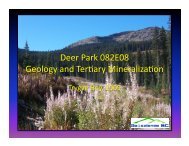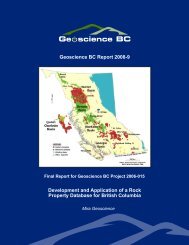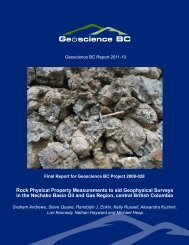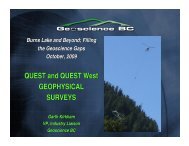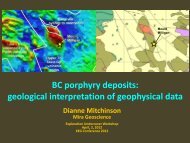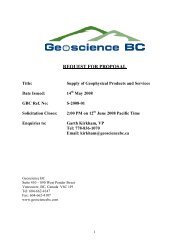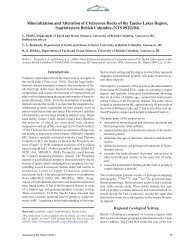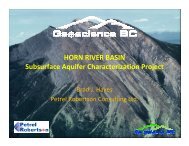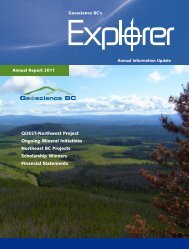Notes Accompanying Original Release of Maps - Geoscience BC
Notes Accompanying Original Release of Maps - Geoscience BC
Notes Accompanying Original Release of Maps - Geoscience BC
- No tags were found...
You also want an ePaper? Increase the reach of your titles
YUMPU automatically turns print PDFs into web optimized ePapers that Google loves.
Metallogenesis <strong>of</strong> the Iskut River Area, Northwestern B.C. --- Regional maps, Lewis<br />
rocks, and volcanic flows within the Betty Creek<br />
Formation are assigned to the Brucejack Lake<br />
Member. These rocks are well exposed in reference<br />
sections at Brucejack Lake, south <strong>of</strong> John Peaks, and<br />
Johnny Mountain. Dacites in the Granduc Mountain<br />
area are also included within the Brucejack Lake<br />
Member. Rocks previously mapped as Betty Creek<br />
Formation in its type area near the Salmon Glacier<br />
are included within the Brucejack Lake Member. The<br />
Brucejack Lake Member is not recognized in the north<br />
central part <strong>of</strong> the map area at Eskay Creek or<br />
between Snippaker and Harrymel Creeks.<br />
Near Granduc Mountain, the Brucejack Lake<br />
member comprises a megaclastic breccia and laterally<br />
equivalent lapilli tuff which overlies bedded crystal to<br />
dust tuff and volcanic conglomerate. To the north,<br />
water-lain crystal and ash tuffs just south <strong>of</strong> John<br />
Peaks, and multiple thin cooling units <strong>of</strong> crystal-rich<br />
welded lapilli tuff at Treaty Creek are likely<br />
equivalents. Possible vent areas for the tuffs at<br />
Brucejack Jake comprise massive, flow banded dacite<br />
domes which grade outward into autobreccia and<br />
massive, hematitic mud matrix volcanic breccia, and<br />
potassium-feldspar megacrystic flow-banded flows.<br />
In the western Iskut River area at Johnny Mountain,<br />
dacitic to rhyolitic flows and welded lapilli tuff which<br />
overlie the lower Hazelton andesite-dacite sequence<br />
form the Brucejack Lake Member.<br />
Age:<br />
Numerous new U-Pb dates indicate that the<br />
early pulse <strong>of</strong> felsic volcanism in the Hazelton Group<br />
near Iskut River spanned a 5-10 million year period.<br />
The oldest age <strong>of</strong> 194 ± 3 Ma was obtained from<br />
flow rocks interlayered with lapilli tuff at Johnny<br />
Mountain (M.L. Bevier, pers. comm., 1994). This<br />
section also represents some <strong>of</strong> the most felsic rocks<br />
included in the Brucejack Lake Member. Zircon<br />
extracted from bedded ash tuffs at John Peaks yielded<br />
a slightly younger U-Pb age <strong>of</strong> 190 ± 1 Ma (R.<br />
Anderson, pers. comm., 1994). Several other isotopic<br />
ages fall within the 185-188 Ma range: Vent-related<br />
dacite at Brucejack Lake yields U-Pb dates <strong>of</strong> 185.6<br />
± 1.0 Ma and 185.8 ± 1 Ma. Laterally equivalent<br />
potassium feldspar megacrystic dacite flows yield<br />
overlapping ages <strong>of</strong> 187.7 +5.8 / -1.5 Ma. In the<br />
Granduc Mountain area, the dacite breccia is nearly<br />
identical in age to Brucejack samples at 186.6 ± 5.6<br />
Ma.<br />
Treaty Ridge Member: Upper sedimentary<br />
sequence<br />
Heterogeneous sedimentary strata including<br />
sandstone, conglomerate, turbiditic siltstone, and<br />
limestone characterize the Treaty Ridge Member <strong>of</strong><br />
the Betty Creek Formation. Many <strong>of</strong> the rock types<br />
<strong>of</strong> the Jack Formation are present in the Treaty Ridge<br />
Member, but the occurrence <strong>of</strong> clasts derived from<br />
Unuk River member volcanic rocks, and the absence<br />
<strong>of</strong> the distinctive granitoid clast conglomerate serve<br />
to differentiate the two units. In areas lacking strata<br />
<strong>of</strong> the Unuk River and Brucejack Lake Members,<br />
such as near the Bruce Glacier, the base <strong>of</strong> the Treaty<br />
Ridge member is difficult to establish.<br />
The Treaty Ridge Member varies from a few<br />
metres to several hundreds <strong>of</strong> metres thick. Thickest<br />
measured sections are present at Treaty Creek and<br />
Eskay Creek, while at Johnny Mountain the unit is<br />
non-existent. The most distinctive rock type within<br />
the unit consists <strong>of</strong> rusty brown to tan weathering,<br />
bioclastic sandstone and intercalated siltstone or<br />
argillite. At Salmon Glacier, this rock type forms a<br />
layer 2-3 m thick, and represents the total thickness<br />
<strong>of</strong> the Treaty Ridge Member. To the north at Treaty<br />
Ridge, the bioclastic unit is succeeded by a several<br />
hundred metre thick turbiditic mudstone to sandstone<br />
section. Bioclastic sandstones are also present in the<br />
Member at Eskay Creek and John Peaks, where they<br />
are interstratified with siltstone, arenitic sandstone,<br />
and heterolithic rounded cobble conglomerate. West<br />
<strong>of</strong> these areas, a thick, grey weathering, mediumbedded<br />
limestone and siltstone sequence is a probable<br />
stratigraphic equivalent.<br />
Age:<br />
Abundant and diverse fauna within the Treaty<br />
Ridge Member which span Upper Pliensbachian to<br />
Upper Aalenian stages (Nadaraju, 1993) suggest that<br />
the unit records a long period <strong>of</strong> volcanic quiescence.<br />
Upper Pliensbachian ammonite collections provide age<br />
constraints at three locations: at Eskay Creek,<br />
bioclastic sandstones contain ammonites Tiltonicerous<br />
cf. propinquum and Protogrammoceras. A<br />
lithologically similar section at John Peaks and<br />
interstatified limestone and siltstone sections to the<br />
west at Lyons Creek both yield the Kunae Zone<br />
(Upper Pliensbachian) ammonite Arieticeras cf<br />
algovianum. At Treaty Creek the base <strong>of</strong> the member<br />
is slightly younger: here diverse faunal collections from<br />
the bioclastic sandstone includes Toarcian belemnites<br />
(G. Jakobs, J. Palfy, pers. comm.). Higher in this same<br />
section, ammonites Tmetoceras cf. Kirki, Leioceras,<br />
80





